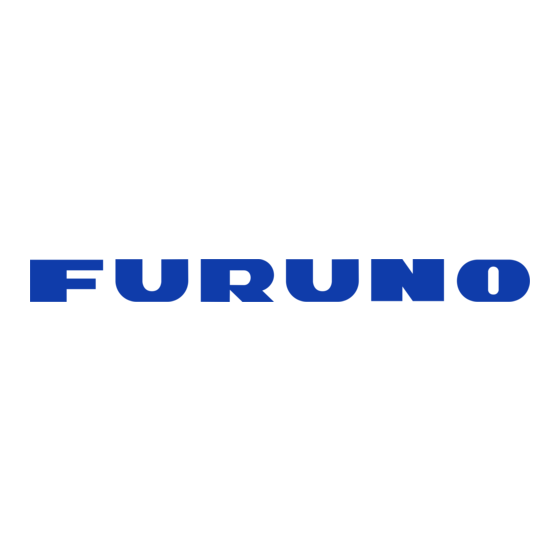

Furuno CSH10 User Manual
Hide thumbs
Also See for CSH10:
- Installation manual (133 pages) ,
- Operator's manual (137 pages) ,
- Installation manual (98 pages)
Advertisement
Quick Links
CSH10 User Menu Training Video Outline
Purpose: Create instruc�onal videos to show what effect the User Menu se�ngs have on the echo
image of the CSH10. Incorporate these videos into a master training library for end users and
technicians.
CSH10 User Se�ngs: There are21 se�ngs in User Menu, they are related to the echo image.
1. TX Interval: Manual Se�ng, Random 1-4, and External Sync.
a. TX Interval Video:
b. Manual: The higher the value the faster the ping rate. This is a fixed ping rate based on
the sonar range.
c. Random 1-4: Selec�ng a Random Transmission can enhance the effec�vity of the
Interference Rejec�on
i. Changes the transmission intervals to avoid interference ring caused by the
same TX frequency. A larger se�ng increases the available intervals used for the
random change.
d. External Sync: Se�ng for synchronized transmission by using Key Pulse for purpose of
Interference Rejec�on. This se�ng requires a signal input from another source for
transmission to occur.
2. TX Pulse Length: If you select higher value the Pulse Length becomes longer. Values 1-9
a. TX Pulse Length Video:
Setting: 0
TX Interval Se�ng
TX Pulse Length Se�ng
Setting: 4
Continue To Next Page
Setting: 9
1
2
Advertisement

Summary of Contents for Furuno CSH10
- Page 1 CSH10 User Menu Training Video Outline Purpose: Create instruc�onal videos to show what effect the User Menu se�ngs have on the echo image of the CSH10. Incorporate these videos into a master training library for end users and technicians. CSH10 User Se�ngs: There are21 se�ngs in User Menu, they are related to the echo image.
- Page 2 Setting: 85.5kHz Setting: 83.5kHz 5. Horizontal Beam Width: You can change the Receiving Beam Width of CSH10 by bearing or circumference. The lower the value the wider the Horizontal Beam Width. The higher the value the narrower the Horizontal Beam Width: Values 1-5 a.
- Page 3 6. Ver�cal Beam Width: You can change the Ver�cal Beamwidth of both the transmission and receiving beam of the CSH10. The lower the value the wider the Ver�cal Beam Width. The higher the value, the narrower the Ver�cal Beam Width: Values 1-5 a.
- Page 4 AGC Near: AGC means Automa�c Gain Control. AGC Near can suppress gain within the Near AGC Distance that is set in the (System Menu). Used to suppress unwanted echoes, the higher the value the more suppression of the echo image. Values 0-10 a.
- Page 5 11. Noise Suppression: Removing or suppressing noise from weak echoes such as sea cluter, plankton, distant sea botom, or propeller noise* can help you clear the display. The noise suppression func�on adjusts the gain level for weak echoes only, leaving schools of fish echoes unadjusted.
- Page 6 13. Noise Limiter: This is similar to a cluter func�on in some Furuno fish finders. If you select a higher value, the more suppression for low level colors. This func�on hardly affects high-level or strong colors. Values: 0-10 a. Noise Limiter Video: Noise Limiter Se�ng...
- Page 7 14. Signal Level: This func�on is the same as that of the conven�onal FSV series. You can get rid of the selected colors from the screen. As you increase the Signal Level value the number of colors to display the echo decreases; similar to delete color. Values: 0-31 a.
- Page 8 15. Color Se�ngs: You can select a color palete of 4 original color paletes as follows. And you can create your own color palete by adjus�ng each color on the selected color palete. a. Color Se�ngs Video: Display Color Se�ng b.
- Page 9 The CSH10 can have up to 10 different Color Curve Paterns as they can be saved to a P- Se�ng. Please remember if you create a customer Color Curve patern, you must save it to a P-Se�ng a�er making changes.
- Page 10 Color Curve Settings Cont. When using Color Curve se�ngs and Color Response se�ngs below are a couple of ideas. • When using for botom discrimina�on and tonnage es�ma�on: o Do not make a dent in Color Curve. Linear Curve, no dents. Expand the middle if By decreasing color of there are no issues.
- Page 11 17. Echo Average: The echo average function adjusts echo image rise time and echo image afterglow (the amount of time an echo signal remains on the display). This feature can be useful for watching echo movement. Adjust the settings so that the target is clearly visible on the display.
- Page 12 18. Interference Rejector 1: This is a se�ng to eliminate unwanted reflec�ons appearing randomly. Values: Off, Weak, Strong a. Interference Rejector 1 Video: Interference Rejec�on1 Se�ng b. Interference Rejector Off- No interference rejec�on occurring. c. Interference Rejector Weak- The system will compare 3 separate pings and display the echo image of the medium echo image.
- Page 13 20. Smooth Echo Range: Use this se�ng to smooth the echo image by the range. The higher the se�ng the more smoothing is applied to the echo image by range. Values: 0-5 a. Smooth Echo Range Video: Smooth Echo Range Se�ng Smooth Echo Range: 0 and 5 21.










Need help?
Do you have a question about the CSH10 and is the answer not in the manual?
Questions and answers